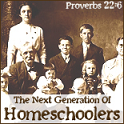The Charlotte Mason Method
By Karen Andreola
Many who have heard of Miss Mason's term -- "living books" -- have benefited from using whole books and firsthand sources rather than relying on dry-as-dust textbooks. If you are able to access a wide range of living books, you will be surprised how much your children will improve in all traditional school subject areas!
Living books, often called "classics," are the kind of books that joyfully enliven the imagination of a child. They are written by individuals -- not committees -- and display imagination, originality, and the "human touch." Living books do not talk down to a child's level or omit odd and interesting vocabulary. Children take to living books more than textbooks for these reasons; because such books are not crammed with facts and information at the expense of human emotion.
How can you recognize a living book? First examine the book yourself to see if it promotes noble thoughts rather than a jaded or misleading outlook on life. If so, simply give the book, whether fiction or non-fiction, the one-page test. Start reading it aloud and look for signs of it opening the doors of the child's mind. You will know it's a living book when you hear them beg, "Read me more!"
A homeschool cannot function without enthusiasm and curiosity. Enthusiasm enables the child to educate himself. Curiosity makes the child want to learn!
A homeschool that runs on the fuel of a child's wonder and imagination, rather than the artificial stimulus of grades, prizes, and happy-face stickers, is on the right track.
The Power of Narration
We cannot apply knowledge to children like we apply suntan lotion to the skin. Knowledge is more the result of what is happening from within, more like the results of a well-digested, nourishing meal. Children gain knowledge through the act of digesting living books. When children are in contact with the thoughts of thinkers, they become more thoughtful. (A good tongue twister to remember.)
As teachers, we should not stand in the way of this contact by constant lectures or excessive explanation. We must not attempt to do the learning for the child. He must do his own learning for the thoughts to become personal, to become his possession.
What did Charlotte Mason recommend to take the place of classroom lectures? Narration. Miss Mason said that asking a child to narrate -- that is, "tell back" or "write down" -- what he has learned is the best way for him to acquire knowledge from books. Because narration takes the place of questionnaires, paragraphs of fill-in-the-blanks, and multiple-choice tests, it enables the child to use all his mental faculties. He responds with his own paragraphs as he tells his version of what is read. When given books of literary quality, his mind does for itself the sorting, sequencing, selecting, connecting, rejecting, and classifying which workbooks or cleverly correlated curriculum attempt (usually futilely) to teach him!
With narration a child calls upon the picturesque vocabulary and descriptive powers of his favorite authors. He does not need an overly concerned teacher's guide instructing him to stop and look up a long list of words he "should" be gleaning from the text. Any vocabulary he leaves out of his narration now will assuredly and naturally be picked up later.
It is ideas that our minds feed upon, not facts and information alone. Give children the opportunity to be in touch with at least one new idea a day through living books and the use of narration, and they will become real thinkers, independent of thick workbooks and much-too-cleverly prepared study guides. Your teaching experience will be one of leading and drawing forth, not one of pushing.







No comments:
Post a Comment